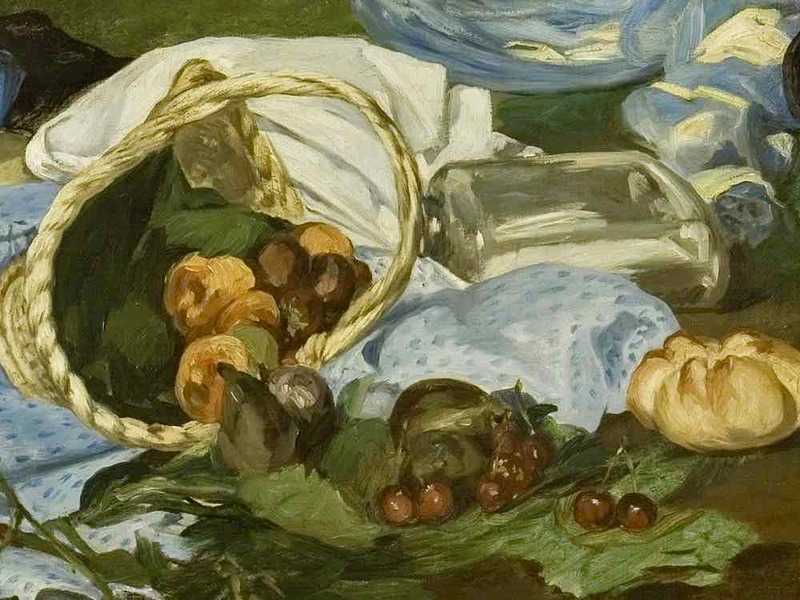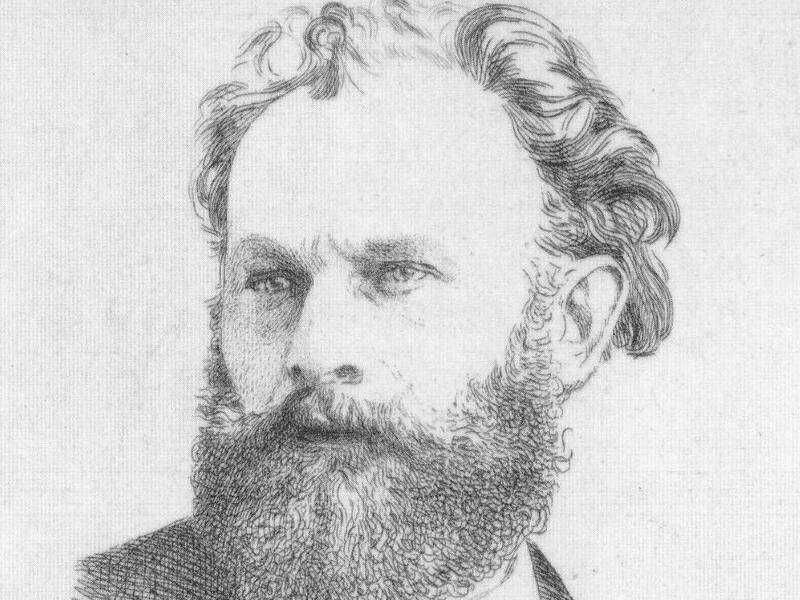1. The Painting
The massive Dejeuner sur l'Herbe was inspired by classical paintings, but with a huge contemporary twist.
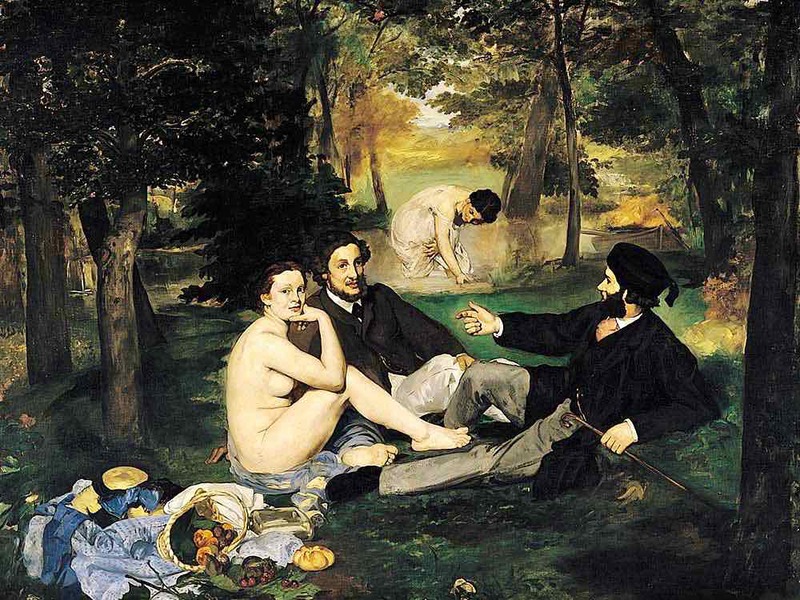
Manet in 1862
By 1862, when Edouard Manet started Dejeuner sur l'Herbe, Manet was 30 years old. He had already led an interesting life, having joined a merchant navy expedition to Rio, studied painting in a Parisian studio, and had mixed results when he submitted his works to the annual exhibition of the French Fine Arts Academy.
The key thing to note is that Manet was not at this stage an established painter. Instead, he was desperately trying to make his name.
The scene
The most striking thing about Manet’s canvas is the naked woman in the foreground. She is painted completely at ease, staring unapologetically at the viewer. The eye is then drawn to the two clothed young men lounging with her: they are not from classical times but dressed in the latest Parisian fashions.
As the French writer Michel Deon put it:
"The real scandal lies not in the naked woman but in the fact that her two companions are fully dressed. Had they been naked too they would barely raise an eyebrow. Among friends, Manet called his painting The Foursome. Yes indeed, what are these two dandies waiting for to indulge in the pleasures of their hedonistic lives?"
Closer inspection reveals the woman’s hat and clothes strewn on the floor (bottom left of the painting) and a picnic basket that has been knocked over – with bread, peaches, cherries and even (it seems) an oyster on the forest floor.
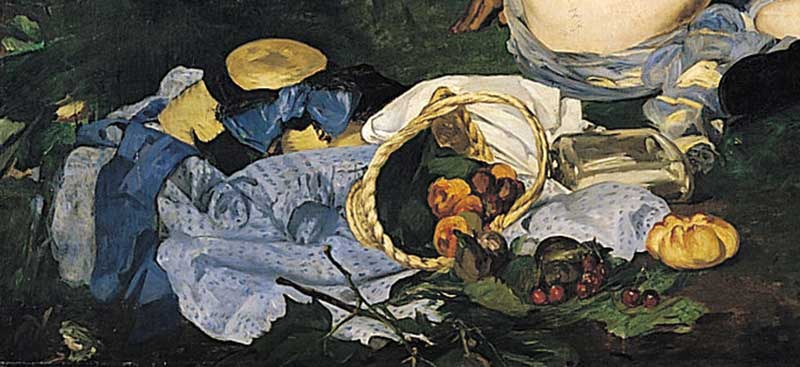
The next thing to note is the woman in the mid-ground. She is wearing some sort of dress, perhaps a nightdress and appears to be bathing. But why if this is really a painting of a picnic? And why is there a rowing boat next to her?
The viewer then sees that either the clothed woman in the mid-ground is a giant or that something has gone wrong with the perspective of the picture.
Further inspection reveals that:
- the forest canopy has been painted with wide brush strokes and seemingly very quickly (these are key impressionist traits).
- the painting appears to be very 'flat', with the the naked flesh of the principal character painted in a uniform and bright tone and without much shadow.
Finally, and I only noticed this when looking at the original in the Musee D’Orsay, one notices a beautiful red-breasted bird flying above the central scene and a little frog on the bottom left hand corner.
Interesting fact...
Manet liked hiding little jokes in his paintings. In Dejeuner sur l'Herbe it is a frog in the bottom left hand corner, in Olympia it is a cat with a raised tail painted in the shadows, and in Masked Ball at the Opera it is the dangling legs of an acrobat at the top of the painting!
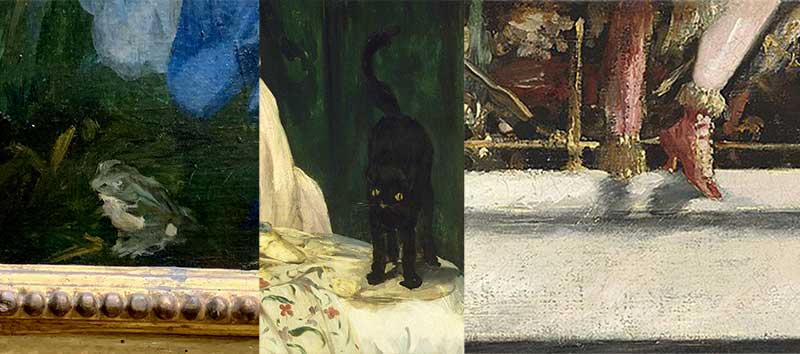
The size
Another striking aspect of the picture is its size: the canvas measures 208 x 264.5 centimetres. In other words, the characters are almost life-sized. This must have contributed to the impact the painting made on critics and the public.
Inspiration
Manet drew inspiration for his painting from the old masters, who he had spent years studying in the Louvre. There are particular parallels between Dejeuner sur l'Herbe and Raphael's Judgement of Paris and Titian's Pastoral Concert, below.
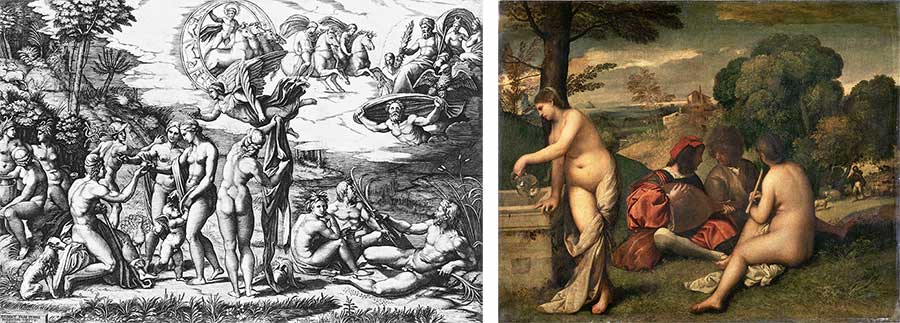
But Manet's take was very different: he painted a contemporary scene; and his nude wasn't looking coy or engrossed in activity - she was studying the viewer studying her!
What's in a name?
When Dejeuner sur l'Herbe was exhibited in 1863 Manet gave it the name "Le Bain" or "Bathing" in English. This didn't make much sense as the central figures were lounging on the forest floor having a picnic.
Manet later changed the name to 'The Square Part' and finally settled on Dejeuner sur l'Herbe (Luncheon on the Grass).
But Manet's informal name for the painting, The Foursome (La Partie carree), is probably more accurate!
The figures
Art historians are able to identify three of the four figures in the scene (not the clothed female in the background). They are:
- Victorine Meurent (1844-1929?), one of Manet's favourite models - a nineteen year old living in Montmartre, who also appears in Manet's Olympia.
- Manet's younger brother, Eugene Manet (1833-1892) (sitting next to Victorine). (In fact, Manet spent so much time working on the painting that his other brother, Gustave, had to deputise for Eugene!)
- Ferdinand Leenhoff (1841-1914), Manet's brother-in-law.
2. The Reaction
The public and the critics hated Luncheon on the Grass. But it inspired the impressionists and generations of painters to come.
Rejection from the Salon
In early 1863, Manet submitted Dejeuner sur l'Herbe to the annual exhibition of the Fine Arts Academy (Academie des Beaux Arts) known as the Salon. But it was rejected by the conservative jury, who disliked any attempt to push artistic boundaries.
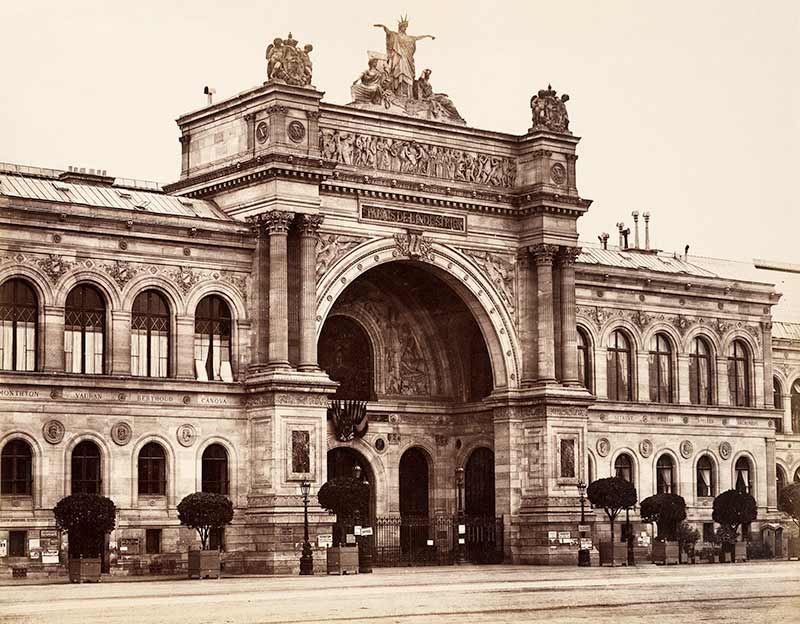
The 1863 Jury was particularly harsh: of the c. 5,600 entries, they rejected about 2,800. This caused uproar amongst the bohemian population of Paris, and Emperor III (sensing a political opportunity) ordered that the rejected artworks be displayed in an "Salon des Refuses" (Exhibition of the Rejects) in a gallery (the Palais de l'Industrie) adjoining the official Salon.
The Exhibition of Rejects
Unlike many painters, who decided that they would rather not exhibit their works at the Salon des Refuses, Manet was keen to display his canvas. The reaction was harsh.
One reviewer questioned whether Manet had painted the picture with a "floor mop", and another likened the individuals shown to "marionettes" (puppets). A third wag suggested that the painting might be Manet's idea of an elaborate practical joke!
Adrein Paul's write-up was similarly critical:
"Some seek ideal beauty. M. Manet seeks and finds ideal ugliness. His two students chatting with the must vulgar of women provoked the astonishment of many people."
Cartoons also lampooned Manet's work.
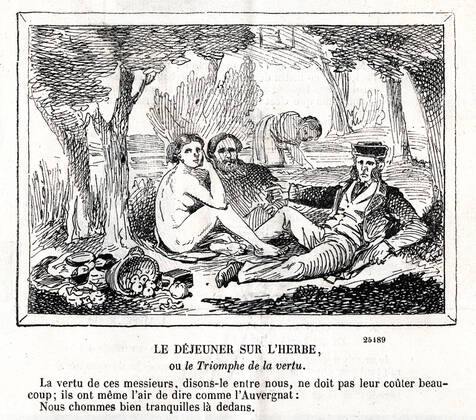
The impressionists pay homage
But the impressionists thought otherwise.
One critical by-product of the harsh reviews is that Manet became infamous in Paris. Edgar Degas, for example, said that Manet had become as famous as Giuseppe Garabaldi (an Italian general at the time, after whom the eponymous biscuit was named)!
And so Manet became the de-facto leader of the impressionists, inspiring the other members of the group to produce paintings in a new style.
Claude Monet painted his own version of Lunch on the Grass the following year, though it is in some ways a more traditional work - nobody is naked and the picnic is neatly laid out on a blanket.
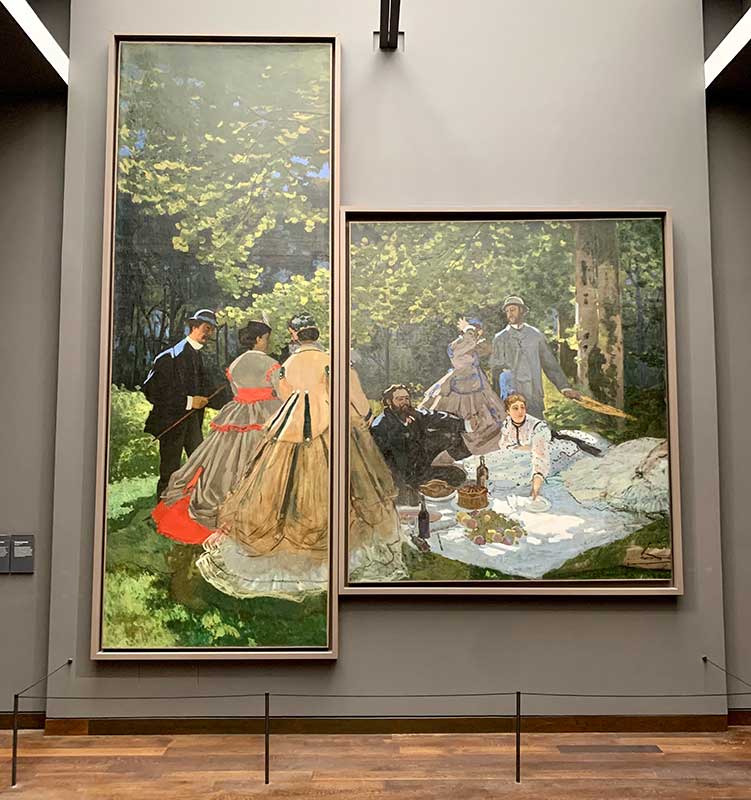
That said, Monet's version of Dejeuner sur l'Herbe is interesting for other reasons:
- Monet decided to paint an enormous canvas, measuring 4 x 6 metres and featuring 12 people. In order to do so, he had to design and build a complicated trench and pulley system.
- When Monet failed to sell the painting, his landlord seized it as security against the payment of Monet's rent. The landlord stuck the painting in his cellar, where it became mouldy. When Monet got the canvas back he was only able to rescue portions of it. Two of them are displayed in the Musee D'Orsay, opposite Manet's Dejeuner sur l'Herbe, with a smaller study for the original in Moscow's Pushkin Museum.
Frederic Bazille and Paul Cezanne also painted homages to Manet's work. Bazille's, painted in 1868, was called Family Reunion, whilst Cezanne produced his largely blue canvass in 1876.

Picasso's obsession
Pablo Picasso, the most famous artist of the 20th century, was also obsessed with Manet's work: he painted no fewer than 26 paintings, six engravings and 140 drawings using Luncheon on the Grass as his inspiration.
Picasso knew that he would become obsessed with Manet's painting when he first saw, it remarking:
"I tell myself, tribulations for later."
3. Where can I see it?
Dejeuner sur l'Herbe is now one of the most important impressionist paintings held by Paris' Musee D'Orsay.
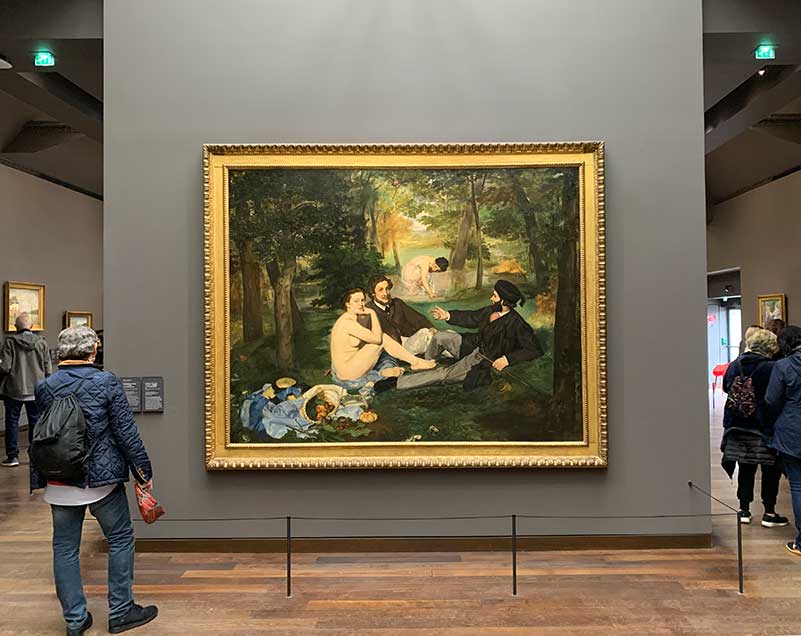
It is displayed in a large, bright room on the D'Orsay's fifth floor - one of the first paintings you see as you enter the galleries. As noted above, Monet's painting of the same name is found directly opposite.
The Courtauld Gallery version
Manet's study for Dejeuner sur l'Herbe is one of the gems of London's newly refurbished Courtauld Gallery. Measuring only 90 x 117 centimetres, and so less than half the size of the D'Orsay's version, the Courtauld version is now thought to be a preparatory study produced by Manet in 1862.
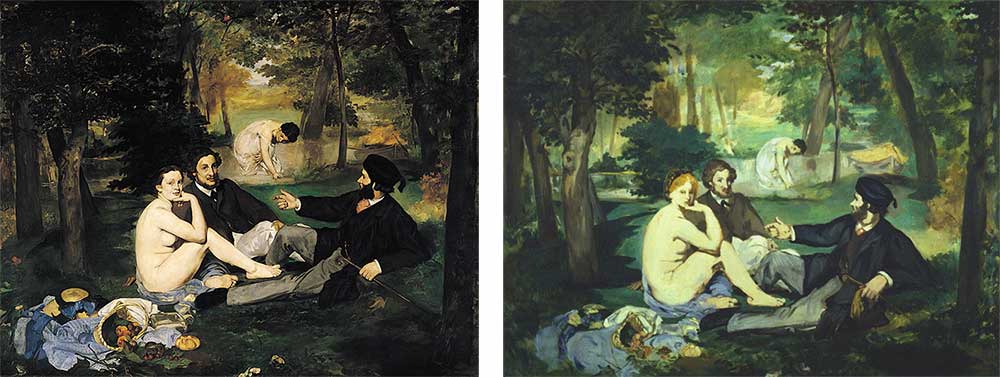
The Courtauld version differs from the D'Orsay version in a number of respects:
- Victorine has ginger hair in the Courtauld version but far darker hair in the D'Orsay version.
- Victorine's expression in the D'Orsay version is more defiant than in the Courtauld version: her chin is raised and her stare more direct.
- There is no frog or flying bird in the Courtauld version!
- Generally the Courtauld version is much less carefully painted than the D'Orsay version, suggesting that it was indeed a preparatory study.


